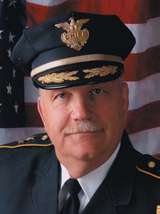 In the past couple of years, no issue in law enforcement has drawn more attention, concern, and controversy than public safety communications and interoperability. The International Association of Chiefs of Police has been actively involved in a number of critical initiatives in these areas, and I wanted to take a moment to review some of them.
In the past couple of years, no issue in law enforcement has drawn more attention, concern, and controversy than public safety communications and interoperability. The International Association of Chiefs of Police has been actively involved in a number of critical initiatives in these areas, and I wanted to take a moment to review some of them.
Simply put, these efforts are crucial to the future of our profession, because, as we all know, clear, simple, and reliable communication is a critical factor in the ability of law enforcement and other public safety officers to respond to emergency situations in a timely, safe, and effective fashion. It is no exaggeration to state that in the highly mobile and often dangerous environment in which our officers work, radio communication is a lifeline that means the difference between triumph and tragedy.
In this issue of the Police Chief, you will read about several national and regional projects that are under way. Each of these projects is designed to develop, foster, and promote new technologies and techniques that will improve the effectiveness of public safety communication in the United States and around the world.
The IACP owes a large debt of gratitude to the members of the IACP Communications and Technology Committee and its chairman, Harlin McEwen. Their tireless efforts have ensured that the needs of the law enforcement community are at the forefront of the debate when proposed solutions are considered.
But in spite of the importance of these national efforts and the promise that new communication technology holds for our departments and our officers, it is equally important that we, as police chiefs, remember that some of the most important communications and conversations we have do not require advanced technologies or complex communication systems. These are the day-to-day conversations that we have with our community members, our colleagues in surrounding jurisdictions, and even our fellow members of the IACP.
Even as police departments adopt new technologies and equipment, we must never forget that the success of our efforts as law enforcement professionals is dependent upon our relationships.
If our communities don’t have confidence in our agencies, they may not trust us, and as a result, they will be hesitant to contact us in times of need and reluctant to assist our agencies when we respond to acts of crime and violence.
If we do not communicate regularly with our colleagues in neighboring jurisdictions, we will be unable to establish an effective partnership between our agencies, and as a result the capabilities of all of our departments will be reduced.
If we do not take advantage of organizations like the IACP to meet with colleagues from around the world, then we will be deprived of the opportunity to discuss common challenges, share information, and learn of new ideas and tactics that allow us to better serve our communities.
Fostering communication and cooperation is not a new mission for the IACP. The IACP was founded 112 years ago by police chiefs who realized that fulfilling their duty required that they work together, that they share information, and that they communicate with each other. Even then, in 1893, they realized that the criminals of their day were often on the move and that law enforcement agencies could no longer confine their efforts to a single jurisdiction, a single county, a single state, or a single nation.
Through the efforts of these visionaries and their successors, the IACP has played a leading role over the years in ensuring that law enforcement agencies around the world have kept pace with advances in transportation, communications, and technology and remain prepared to combat crime effectively in today’s highly mobile and fast-paced environment. As the articles in this issue of the Police Chief make clear, we will continue to do so.
Even as IACP continues its efforts to ensure that our departments can take advantage of 21st-century communication technologies, I urge you to take advantage of the same communications technique that successful police chiefs have used for centuries: talk to your communities and to your colleagues. ■


